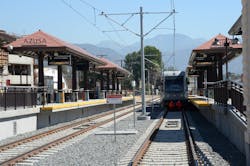Foothill Gold Line Opens Two More Stations
The Foothill Gold Line Construction Authority (Construction Authority) on Sept. 19, held a dedication ceremony for both Foothill Gold Line Azusa Stations – Azusa Downtown Station and APU/Citrus College Station – as they concluded a series of ceremonies with the corridor cities to celebrate the new light rail stations and the upcoming substantial completion for the entire $1 billion, six-station Foothill Gold Line light rail project.
With two stations being dedicated at the event, attendance was diverse and large, with elected officials at all levels of government, transportation officials, higher education officials, foreign dignitaries and close to one thousand community stakeholders attending.
"When this phase of the Foothill Gold Line opens next year, thousands of riders will be able to travel between the San Gabriel Valley and Downtown Los Angeles without a car," said Los Angeles Mayor and Metro Board Director Eric Garcetti. "This new transportation option will relieve traffic, improve mobility and reduce greenhouse gas emissions. It is a smart investment in our region's sustainable future."
In attendance to dedicate the two recently completed stations were dozens of elected officials. Speakers included U.S. Representatives Grace Napolitano and Judy Chu; Los Angeles Mayor and Metro Board Second Vice Chair Eric Garcetti; Los Angeles County Supervisors and Metro Board Members Hilda Solis and Michael Antonovich; State Senator Dr. Ed Hernandez and State Assembly member Roger Hernandez; Metro Board First Vice Chair and Foothill Gold Line Construction Authority Board Member, Duarte City Councilman John Fasana; and Metro Board Member and Glendale Mayor Ara Najarian. Foothill Gold Line CEO Habib F. Balian and Metro CEO Phil Washington both participated, along with Citrus College Superintendent/President Dr. Geraldine Perriand Azusa Pacific University Vice President Emeritus Cliff Hamlow. All spoke at the historic occasion. AzusaMayor Joseph Rocha welcomed everyone to the dedication, and KNX 1070 Newsradio host Frank Mottekserved as the event's emcee.
"It is an honor to be here today, in appreciation of a city and a community that has supported this project for over a decade," stated Foothill Gold Line Construction Authority CEO Habib F. Balian. "This tremendous success is due in large part to the grassroots support for the project by elected officials that have represented the project's past, present and future and the Authority's partnership with each of the Foothill Gold Line cities and Metro."
The Azusa Downtown Station is located on Alameda Avenue, just north of Foothill Boulevard, in the heart of downtown Azusa. The station was fully revealed to the public for the first time at the dedication and features unique artwork created by public artist Jose Antonio Aguirre. Titled "A Passage Through Memory," the station artwork is inspired by the tribal and architectural history of the region. The platform ramps on both station platforms feature 16-foot-tall arched portal structures that serve as gateways to and from Azusa for future riders. The concrete arched section of the portal is styled after the early California Spanish colonial missions, while the metal 'crown' that sits atop and casts a glowing "AZUSA" sign at night is inspired by the original "AZUSA" sign created in 1923. And encircling every column base on the station platforms are mosaic tile art pieces, whose designs are inspired by the basket weavings of the Native American Gabrielino tribes of the San Gabriel Valley.
The APU/Citrus College Station is the temporary terminus of the Gold Line. It is located just north of Foothill Boulevard and west of Citrus Avenue, adjacent to two higher education campuses: Azusa Pacific University andCitrus College. The station features unique artwork created by public artist Lynn Goodpasture, titled "Azusa Horticultural Paradise," that pays homage to the area's natural heritage and the individuals who shaped and transformed the landscape over time. Four custom-cast, mosaic-tiled benches on the platform feature designs of natural landscape elements that were either native to the area or were introduced by past pioneers: the oranges and honey bees; the Western Sycamore, an indigenous tree; Wild Hyacinths, a once-prolific wild flower; and Rosedale's Beauty, one of the most popular camellia flowers propagated during the 1950s. The ticket vending machine canopy features hand-painted glass art panels with designs based on the California Fan Palms that were thought to have been introduced in 1899.
